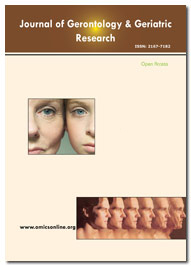ఇండెక్స్ చేయబడింది
- J గేట్ తెరవండి
- జెనామిక్స్ జర్నల్సీక్
- సేఫ్టీలిట్
- RefSeek
- హమ్దార్డ్ విశ్వవిద్యాలయం
- EBSCO AZ
- OCLC- వరల్డ్ క్యాట్
- పబ్లోన్స్
- జెనీవా ఫౌండేషన్ ఫర్ మెడికల్ ఎడ్యుకేషన్ అండ్ రీసెర్చ్
- యూరో పబ్
- గూగుల్ స్కాలర్
ఉపయోగకరమైన లింకులు
ఈ పేజీని భాగస్వామ్యం చేయండి
జర్నల్ ఫ్లైయర్

యాక్సెస్ జర్నల్స్ తెరవండి
- ఆహారం & పోషకాహారం
- ఇంజనీరింగ్
- ఇమ్యునాలజీ & మైక్రోబయాలజీ
- క్లినికల్ సైన్సెస్
- జనరల్ సైన్స్
- జెనెటిక్స్ & మాలిక్యులర్ బయాలజీ
- నర్సింగ్ & హెల్త్ కేర్
- న్యూరోసైన్స్ & సైకాలజీ
- పర్యావరణ శాస్త్రాలు
- ఫార్మాస్యూటికల్ సైన్సెస్
- బయోఇన్ఫర్మేటిక్స్ & సిస్టమ్స్ బయాలజీ
- బయోకెమిస్ట్రీ
- మెటీరియల్స్ సైన్స్
- మెడికల్ సైన్సెస్
- రసాయన శాస్త్రం
- వెటర్నరీ సైన్సెస్
- వ్యవసాయం మరియు ఆక్వాకల్చర్
- వ్యాపార నిర్వహణ
నైరూప్య
Approach to Pain in the Elderly
Raim Iliaz, Gulistan Bahat Ozturk, Timur Selcuk Akpinar, Asli Tufan, Irem Sarihan, Nilgun Erten and Mehmet Akif Karan
Pain is the most common complained symptom in the elderly. Acute pain prevalence does not change with aging. However, chronic pain is much more prevalent in the elderly compared to young individuals. Despite these facts, pain in the elderly is commonly assessed and treated inadequately. The treatment goal of pain in the elderly is not always complete eradication of pain but decrease in pain allowing the improvement in activities of daily living and quality of life. Nonpharmacological-pharmacological approaches and anesthetic/invasive interventions can be used for pain treatment. During pharmacological treatment, the changes related to aging should be considered enabling increased side effects and drug-drug interactions. Generally, the stepwise guideline suggested by World Health Organisation for cancer pain is valid also for the treatment of chronic pain. Acetaminophen is the safest and mostly preferred analgesic in treating mild-moderate pain in the elderly. Metamizole is also free of gastrointestinal and thrombocyte related side effects. It is widely used in available countries for the pain in elderly with more intense and spasmolytic analgesic effect compared to other non-opioids. Nonsteroidal anti-inflammatory drugs can be used in moderate-severe pain. However, they should not be used in high doses and/or for a long time due to their severe side effect profile. Opioids are effective in all pain types and used in severe pain. The elderly is more prone to both analgesic effect and side effects of opioids. The most important side effects of opioids are respiratory depression, sedation, cognitive problems, emesis and constipation. Recently, they are being more suggested for the treatment of chronic non cancer pain in the elderly. If the pain is not controlled with these measures, the next step is the use of anesthetic/invasive modalities. In these cases, the elderly should be referred to centers specialized on pain. The aim of our study is to summarize the general approach to acute and chronic pain in elderly.